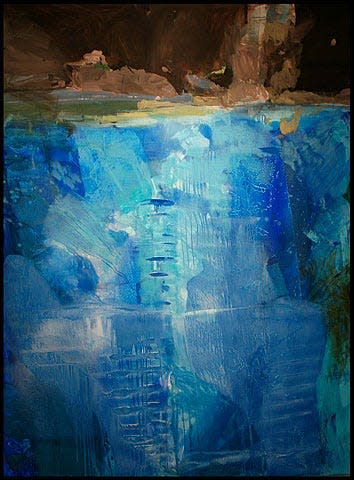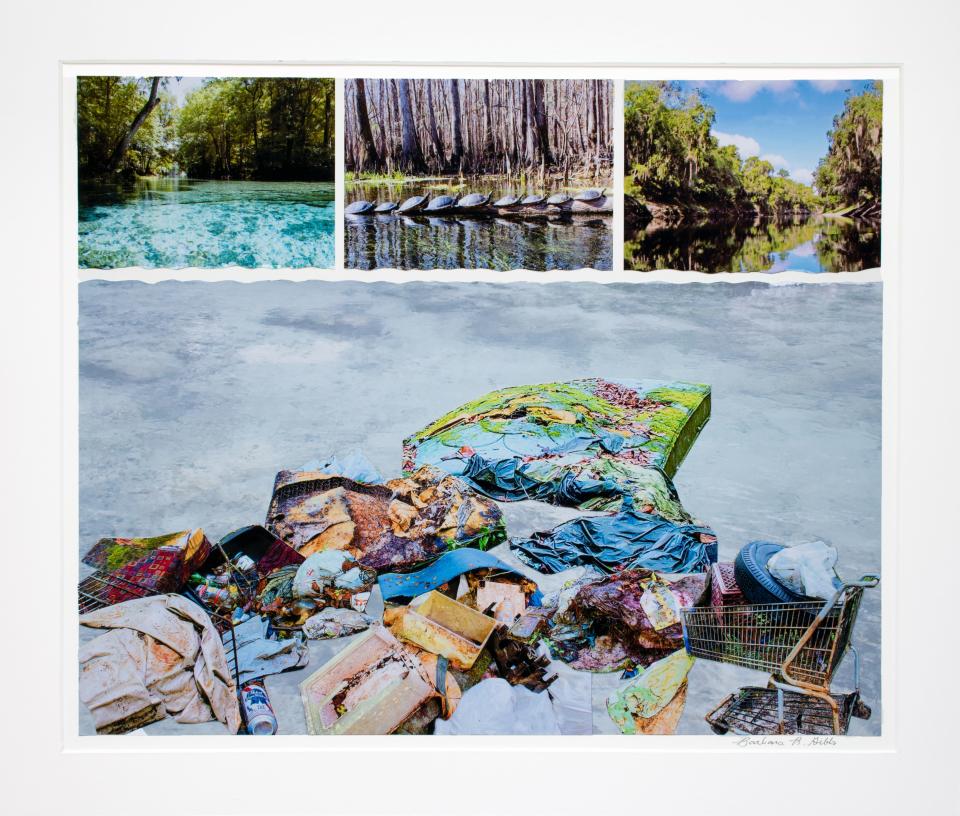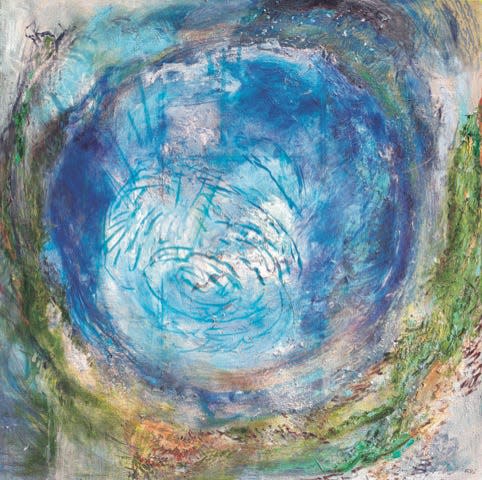The artist and the environment: using art to save Florida’s iconic springs

When she viewed a retrospective exhibition of her paintings of Florida springs, Gainesville artist Margaret Ross Tolbert was shocked to discover that, “My paintings were showing different colors of green in the spectrum of blues, and I finally realized this was no artistic innovation on my part, but it was that I was seeing the brilliant green of algal growth in the springs' headwaters, where once the dark strands of eel grass waved beneath the surface. I was seeing (and documenting) the effects of reduced flow (or discharge) in the springs, some of which have decreased several levels of magnitude.”
Since that time, Tolbert has been very involved in using her art to advance environmental awareness and to educate her viewers about the plight of Florida’s fabled springs. As a member of the World Springs Project, she has traveled widely, met with environmental groups worldwide and written a book, “AQUIFERious,” that includes essays by respected environmentalists and nature writers along with images of her artwork.
“One thing that is unique about our area is the number of diverse talents and specialties that reveal different facets about the springs,” Tolbert said.
More Messages for the Springs Heartland:
'Messages from the Springs Heartland' meant to inspire action to save our springs
Stop subsidizing those who harm springs through pumping, pollution
Failure to treat springs as sacred places has led to their impairment
How politics, state funding affect Florida’s water management districts
Many other regional artists are also using their art to alert viewers to the dangers and consequences of ignoring the ongoing degradation of our fabled springs. Diver/photographer Wes Skiles was one of the early voices calling for springs protection and using images of the springs to raise awareness.
Soon, other artists such as nature photographers John Moran and Jeff Ripple joined in — taking pictures and writing books that focused on Florida’s extraordinary natural environment. Moran’s photos of springs “then and now” deserve special mention.
Artists Annie Pais and Stewart Thomas established a nonprofit organization, Florida’s Eden, to publicize the connections between art, culture and Florida’s economy. Pais and Thomas worked closely with the Florida Museum of Natural History to mount a popular springs exhibition in 2010 and incubated the Howard T. Odum Florida Springs Institute, founded by Bob Knight, for its first three years of existence. More recently, painter Merrillee Malwitz-Jipson established Rum 138, a gallery that specializes in art inspired by our springs and rivers.

There are many other names as well — Mark Long, John Dame, Linda Petzl Wilinski, Barbara Gibbs, Leslie Peebles — and others who have been drawn to the magical imagery and mythic resonance of springs phenomena that have inspired artists, writers and poets for centuries.
From the beginning of Florida’s recent history, these “fountains of youth” have been the symbolic cornerstones of our state’s reputation as a special place, a “magic kingdom” filled with mysterious secrets. From Ponce de Leon to William Bartram to Cynthia Barnett, the fountains of Florida have provided inspiration and admiration, making North Central Florida a focal point for environmental awareness and artistic celebration.
But as we look back to admire the natural blessings that we have enjoyed, we need also to look ahead. The springs themselves provide the guidebook to a more somber story — one of neglect and abuse. Given what’s at stake — the beauty and vitality of our natural heritage — we cannot afford to turn away from our responsibility to preserve what was given to us by a bountiful and abundant nature.
Artists are continuing to use the power of their images to capture the imagination of a jaded populace. Photographer Barbara Gibbs has for years used her images to raise awareness of the history and mystery of Florida’s nature and culture. In “Florida’s Bellamy Road: A Place Remembered,” by historian/author Sudye Cauthen, Barbara’s photographs capture an idyllic rural past well worth remembering.

As Margaret Ross Tolbert writes, “I think image makers are those who notice all changes in the springs and in general in life. It’s one reason I return again and again to being a creative artist and painter as the place from which I want to speak about the springs.”
In this season of giving thanks, we can all be grateful for the artists who have advocated for our springs with their beautiful creations. Surely, we all need to use whatever creative resources we have to build awareness and to prompt action. Before it’s too late.
Mallory O’Connor is an art historian and writer. She was for many years the director of the city of Gainesville’s Thomas Center Gallery and later served as director of the gallery at Santa Fe College. Her books include “Xanadu’s Cavern,” a work of fiction with a Florida springs theme, as well as the nonfiction books “Florida’s American Heritage River: Images from the St. Johns Region” and “Lost Cities of the Ancient Southeast.” This column is part of The Sun's Messages from the Springs Heartland series.
Join the conversation
Send a letter to the editor (up to 200 words) to letters@gainesville.com. Letters must include the writer's full name and city of residence. Additional guidelines for submitting letters and longer guest columns can be found at bit.ly/sunopinionguidelines.
Journalism Matters. Your Support Matters.
Get a digital subscription to the Gainesville Sun. Includes must-see content on Gainesville.com and Gatorsports.com, breaking news and updates on all your devices, and access to the Gainesville.com ePaper. Visit www.gainesville.com/subscribenow to sign up.
This article originally appeared on The Gainesville Sun: Mallory O’Connor: Using art to save Florida’s iconic springs

